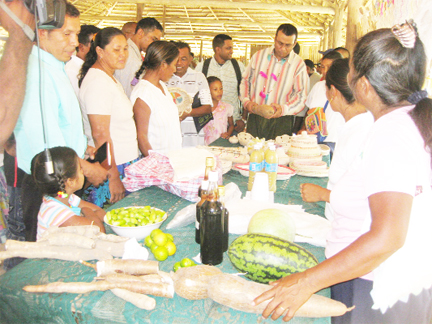
Members of the Amerindian community put on a dance during Tuesday’s ceremonial blessing of the grounds on St Vincent Street, San Fernando, believed to be a former Amerindian burial ground. Photo: Rishi Ragoonath
The site is under construction for a $7 million state-of-the-art community centre in the San Fernando West constituency. Some stakeholders have raised objections to the construction on sacred grounds. Parliamentary Secretary in the Ministry of Community Development, Culture and Gender Affairs, Junia Regrello, said there was no evidence that it was an Amerindian burial ground, but in the face of concerns raised, the project was temporary halted to undertake an investigation to see how authentic the claims were.
After consultation with the Amerindian community, they agreed to bless the site so work could proceed. “We don’t want to offend any community,” Regrello said.
Work is expected to resume today, he added. Led by Chief Ricardo Bharat-Hernandez, the Amerindians called on the great Spirits to consecrate the grounds and forgive any disruptions which may have been caused by the construction. Visiting High Priest from Suriname Harold Taweroe, also led a song and dance around a container filled with dirt, and a half of a calabash filled with water, as the Native Indians smoked their peace pipe and shook their chac-chacs to complete the ritual. Bharat-Hernandez, Deputy Mayor of Arima, said the site, on which a basketball court was presently constructed, may have been an Amerindian cemetery. “I have asked for evidence, but no one could give that evidence. Burial grounds are very sacred, and in the absence of concrete evidence, we performed a simple ritual, as if it were a burial ground, to appease the Spirits and ask the creator to bless what is happening here now,” he said.
Bharat-Hernandez said the First People had no intention of stopping any development of the community. He said he was happy to hear Regrello say they were about putting people first and his intention to create a shrine or special place to preserve whatever remains or artefacts they may find. Bharat-Hernandez also used the opportunity to call on government to recognise the First People and put them in their rightful place. He said all of the other people who came to T&T has been recognised in many ways, but the First People, in spite of their contribution, had not.
“Here we are concerned about the remains of our ancestors, but we have living indigenous people across the world and in our region and we are in a struggle for meaningful recognition.” He said without that recognition, a very important cultural heritage would be lost. “The Minister said we put people first, well I want to tell him to put the First People in their rightful position,” he said.
Author: Yvonne Webb
Source: http://guardian.co.tt/news/general/2009/10/22/amerindians-bless-burial-grounds-sando





